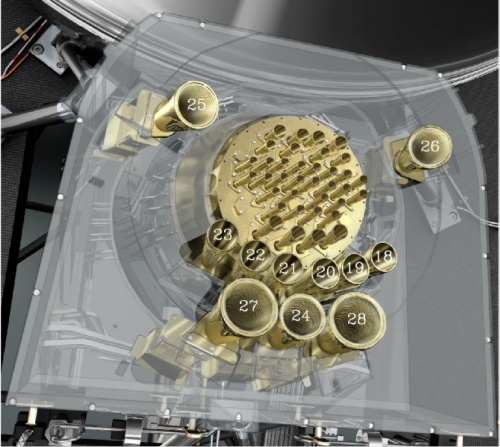Difference between revisions of "Beams LFI"
(→Main Beams and Focal Plane calibration) |
|||
| Line 21: | Line 21: | ||
== Main Beams and Focal Plane calibration == | == Main Beams and Focal Plane calibration == | ||
| + | Describe the RIMO content (beam section) | ||
| + | |||
| + | |||
The beam solid angle, Ω<math>_A </math>, of an antenna is given by | The beam solid angle, Ω<math>_A </math>, of an antenna is given by | ||
Revision as of 11:23, 25 February 2013
Contents
Wish List[edit]
list of information to be inserted in the explanatory supplements
- Description of LFI FOV.
- Description of various telescope models as reported in the beam paper.
- Format of beam data
- Definition of various coordinate frames for beams
Overview[edit]
LFI is coupled to the telescope by eleven dual-profiled, corrugated, conical horns #sandri2010,villa2010: six feed horns at 70 GHz (FH18 – FH23), three feed horns at 44 GHz (FH24 – FH26), and two feed horns at 30 GHz (FH27 and FH28). Each feed horn is connected to an orthomode transducer (OMT) to divide the field propagating into the horn into two orthogonal linear polarization components, X and Y #darcangelo2010a.

The feeds and corresponding OMTs are adjusted in the focal surface so that the main beam polarization directions of the two symmetrically located feed horns in the focal plane unit (FPU) are at an angle of 45 degrees when observed in the same direction in the sky. This configuration permits measurement of the Q and U Stokes parameters and thus the linear polarization of the CMB.
The separation of the power pattern into a main beam and sidelobes can be somewhat arbitrary and is basically governed by convention. Different definitions of these regions could in principle be used: electromagnetic definitions, science-related definitions, and simulation-related definitions. In this framework the main beam region was defined by taking care that not only the relevant main beam characteristics are computed (angular resolution, ellipticity, directivity, cross polar discrimination factor, and so on), but also that the main beam distortion, at a level of about –60 dB (mainly due to the off-axis location of the LFI feed horns), can be evaluated.
Main Beams and Focal Plane calibration[edit]
Describe the RIMO content (beam section)
The beam solid angle, Ω, of an antenna is given by
\Omega where is the normalized power pattern and the field computed by GRASP is normalised to a total power of 4π watt, i.e.,
Effective beams[edit]
TBW
Window Functions[edit]
TBW
Sidelobes[edit]
TBW
References[edit]
<biblio force=false>
</biblio>
(Planck) Low Frequency Instrument
Field-Of-View
LFI Ortho Module Transducer
(Planck) High Frequency Instrument
European Space Agency
Focal Plane Unit
Cosmic Microwave background
[LFI meaning]: absolute calibration refers to the 0th order calibration for each channel, 1 single number, while the relative calibration refers to the component of the calibration that varies pointing period by pointing period.